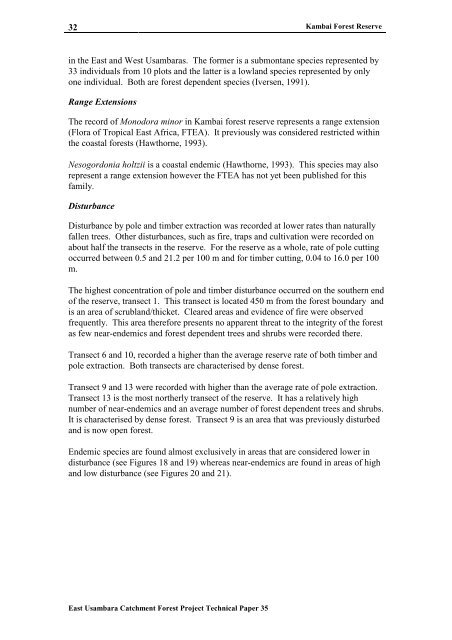East Usambara Catchment Forest Project Technical Paper 35 ...
East Usambara Catchment Forest Project Technical Paper 35 ...
East Usambara Catchment Forest Project Technical Paper 35 ...
Create successful ePaper yourself
Turn your PDF publications into a flip-book with our unique Google optimized e-Paper software.
32<br />
Kambai <strong>Forest</strong> Reserve<br />
in the <strong>East</strong> and West <strong>Usambara</strong>s. The former is a submontane species represented by<br />
33 individuals from 10 plots and the latter is a lowland species represented by only<br />
one individual. Both are forest dependent species (Iversen, 1991).<br />
Range Extensions<br />
The record of Monodora minor in Kambai forest reserve represents a range extension<br />
(Flora of Tropical <strong>East</strong> Africa, FTEA). It previously was considered restricted within<br />
the coastal forests (Hawthorne, 1993).<br />
Nesogordonia holtzii is a coastal endemic (Hawthorne, 1993). This species may also<br />
represent a range extension however the FTEA has not yet been published for this<br />
family.<br />
Disturbance<br />
Disturbance by pole and timber extraction was recorded at lower rates than naturally<br />
fallen trees. Other disturbances, such as fire, traps and cultivation were recorded on<br />
about half the transects in the reserve. For the reserve as a whole, rate of pole cutting<br />
occurred between 0.5 and 21.2 per 100 m and for timber cutting, 0.04 to 16.0 per 100<br />
m.<br />
The highest concentration of pole and timber disturbance occurred on the southern end<br />
of the reserve, transect 1. This transect is located 450 m from the forest boundary and<br />
is an area of scrubland/thicket. Cleared areas and evidence of fire were observed<br />
frequently. This area therefore presents no apparent threat to the integrity of the forest<br />
as few near-endemics and forest dependent trees and shrubs were recorded there.<br />
Transect 6 and 10, recorded a higher than the average reserve rate of both timber and<br />
pole extraction. Both transects are characterised by dense forest.<br />
Transect 9 and 13 were recorded with higher than the average rate of pole extraction.<br />
Transect 13 is the most northerly transect of the reserve. It has a relatively high<br />
number of near-endemics and an average number of forest dependent trees and shrubs.<br />
It is characterised by dense forest. Transect 9 is an area that was previously disturbed<br />
and is now open forest.<br />
Endemic species are found almost exclusively in areas that are considered lower in<br />
disturbance (see Figures 18 and 19) whereas near-endemics are found in areas of high<br />
and low disturbance (see Figures 20 and 21).<br />
<strong>East</strong> <strong>Usambara</strong> <strong>Catchment</strong> <strong>Forest</strong> <strong>Project</strong> <strong>Technical</strong> <strong>Paper</strong> <strong>35</strong>
















